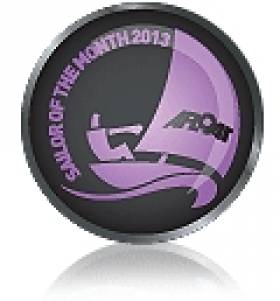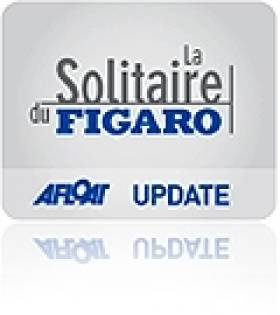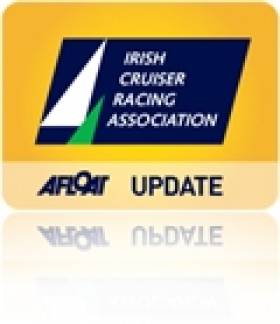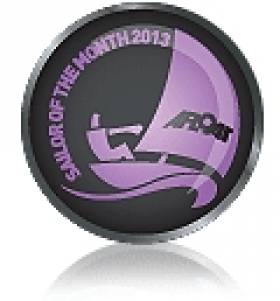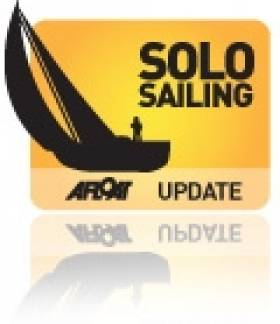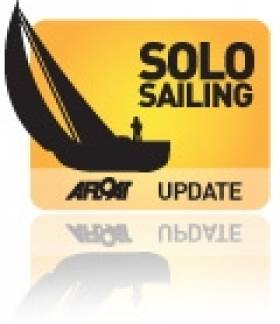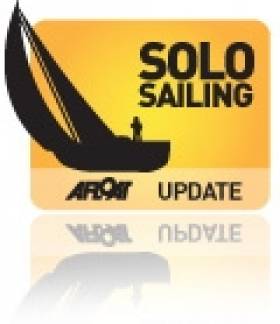Displaying items by tag: David Kenefick
David Kenefick is Irish Sailor of the Year for 2013
#fullirish – It's not hard to argue that 2013 was the biggest year by far in David Kenefick's sailing career. And that he's still only 22 years of age makes his solo sailing achievements over the last 12 months even more remarkable.
Indeed, his performance in the demanding Figaro Solo alone was surely enough to secure his place in our esteem - and garner him Afloat's Irish Sailor of the Year Award for 2013.
Kenefick's prodigious talent backed his claim to the Rookie of the Year title (never before awarded to a non-French skipper) as the youngest in the field running a gruelling Gallic gauntlet of almost 7,000 offshore miles, nearly all of them single-handed.
His year of success began in February - just three months after launching his Figaro bid - when he raced his Figaro one-design yacht for the first time in the 140 nautical miles of La Grande Motte.
Finishing second out of six finishers, the result put Kenefick in good stead for the following month's ICOM Cup Méditeranée in Marseille, where fifth place in the final leg saw him tally 11th overall - one step closer to achieving his long-held ambition.
But qualification for La Solitaire du Figaro was only sealed in April's 320-mile Solo Arrimer race, the longest he'd sailed till that date. And he bettered that rookie podium finish with 15th in May's 30-boat Solo Concarneau, in which he was the second newcomer over the line.
"I now know a lot more about what this kind of racing is," Kenefick told Afloat after that third race, underlining the mental strength that long-distance solo sailing demands.
"It is about training your mind. Your eyes will close but your mind is still going... You have to go there to understand it. It's weird waking up when you are at the helm. It's quite amazing what your body and mind can do."
That invaluable race experience aside, Kenefick also benefitted from the guiding hand of coach and mentor Marcus Hutchinson, himself a Figaro veteran, who put the young Crosshaven sailor through his paces.
Still, it's one thing to prepare and another to actually do it: the Figaro Solo is a unique challenge, the 535 miles of its first leg enough to ward off the weak.
So it was disheartening, though not surprising, to see Kenefick make a poor start off the line from Bordeaux on 2 June, stuck among the backmarkers as the fleet headed up the Gironde Estuary.
Around him strong contenders fell by the wayside in this race of attrition. And Kenefick himself would not emerge unscathed, a "little collision" taking a chunk out of the keel of his yacht 'Full Irish'.
Ultimately, though, it was just a scratch - a battle scar to prove Kenefick's mettle as he completed the first leg in 33rd place out of 41 starters.
But he knew he could do better, rueing the mistake of not sleeping when he had the chance and winding up lost in a tangle of fishing boats.
Light winds saw leg two shortened to 300 nautical miles from Porto to the Spanish port of Gijon - the last 45 of which, as Hutchinson wrote in his Figaro blog, proved the most important.
Sailing much smarter now, Kenefick was in the middle group, best positioned to act upon the telltale signs of stalling winds ahead, and at one point made it to the top 10.
His 18th place finish was a huge boost to his confidence and his chances going into the penultimate leg from Gijon to Roscoff, starting with straight 200-mile run across the Bay of Biscay considered the hardest leg of the course, where barometric pressure trends matter more than tidal charts.
Kenefick suffered on the wrong side of the fleet, putting him far down the rankings to the point where strategy goes out the window and all that matters is staying awake and getting as much speed as possible. But he wasn't the only one, and still reached Roscoff third among the rookies.
After four days of much-needed shore leave, the fleet embarked on the final leg to Dieppe: 520 miles via the south coast of England, an unforgiving route tracing rocky coastlines and tidal gates that demands physical toughness and nerves of steel.
Surviving a scary night-time game of rock dodgems, Kenefick hoisted early and drove hard through the night from Wolf Rock to Needles Fairway, gaining 11 places on the way - though a violent gybe towards the end loosened his mainsail and left him scrambling to improvise a fix.
However, it failed to put a damper on an "amazing" leg for Kenefick, who crossed the line in the small hours of 23 June with a cumulative placing of 28th out of 40 finishers, third among the rookies - and becoming only the fourth Irishman to complete the race after Damian Foxall, Paul O'Riain and mentor Hutchinson.
"If you had said to me last year that I'd be at the finish of the Solitaire," he said, "I don't think I would have believed you."
What an achievement - and yet that wasn't the end of Kenefick's offshore season, as he followed with a strong showing in September's Tour de Bretagne ala Voile, and an even more impressive display in the Generali Solo around the Mediterranean, where he finished 12th as the best rookie in the fleet.
That was enough to clinch the title of 2013's best Figaro newcomer for the young Corkman, who we also recognised as our Sailor of the Month for October.
"No one comes into this scene and performs at the top in their first year," he said as the weight of his achievements began to sink in.
But he did it, and so it was only right that we honour David Kenefick with the Sailor of the Year Award for doing what was previously thought impossible.
For full coverage of David Kenefick's 2013 season click here.
Figaro Prize Giving Kick Starts Kenefick's Figaro for 2014
#figaro – Cork solo sailor David Kenefick was in Paris last weekend to collect his prize for the Championship of France Solo Offshore Racing - one of the most prestigious sailing events in France.
The 22-year-old Royal Cork Yacht Club sailor débuted at the La Solitaire du Figaro in June, the world-renowned race which comprises of four legs of approximately 400-500 miles of single handed sailing. David finished the 2013 session when he became the first non-French person to win the rookie division of the Championship of France of solo offshore racing.
He said: "It's amazing to be the first rookie after a very hard and stressful year. It has given me great encouragement for 2014. The Figaro race was extremely tough but I stuck at it, chipped away all year and learned a lot. Not just about how to do better in this very tough fleet but also about the mistakes I made earlier in the year and how I was going to improve from them. Straight after the Figaro I had some of my sails recut and I've found it has made a difference. I've also been working on trying to secure new sponsors, not only a title sponsor, but small partners and sponsors to join me on board Full Irish for 2014. I have now committed myself to do next year's La Solitare du Figaro and am already fully immersed in my 2014 program. I will move to France in January and begin training on board Full Irish before competing in the Solo Maitre CoQ in April. In May, I will use the Solo Concarneau as one of my last warm up events before the famous La Solitaire du Figaro in June, which is going to be very tough."
Last Weekend the course for the 45th edition for the La Solitaire du Figaro was announced with a total distance of 2014 miles, and looks to be one of the toughest courses of the history of the race. There will be no Irish stop over as was previously hoped for.
The first leg will be from Deauville to Plymouth via the Isle of Wight, Wolf Rock and a laid buoy off Roscoff, before the finish in Plymouth. The first leg alone has three channel crossings - no easy task for a full crew, never mind one person racing alone.
Leg 2 takes the fleet from Plymouth around the Fastnet Rock before finishing in Roscoff.
Leg 3 will be from Roscoff to an unnamed port in the Vendee region. Most of this leg will be raced in inshore waters going south along the French coast, before heading out into the middle of the Bay of Biscay to a buoy before then heading to the finish line.
Leg 4 starts from the Vendee region and takes the fleet back North along the West coast of France, before heading across the English channel leaving Wolf Rock to Port, before sailing down the Channel to the Needles Fairway buoy just off the Isle of Weight, then taking the fleet back across the English channel for the sixth time to the finish in Cherbourg.
David Kenefick's Solo 'Full Irish' Campaign Awarded ICRA's Boat of the Year Prize
#boat of the year – The Cork based solo yacht named 'Full Irish' skippered by 22-year-old David Kenefick has won ICRA's boat of the year award. The decision was announced at today's annual ICRA conference at the Royal Irish Yacht Club in Dun Laoghaire. It is the first time a solo campaign has won Irish cruiser–racing's top prize and reflects a season of highs for the Royal Cork Rookie on the professional French offshore sailing circuit.
He was just 21 when he qualified to become a Figaro 'rookie' mentored by former participant Marcus Hutchinson, and though he turned 22 during June as the 2013 programme accelerated through a demanding season, he continued as the youngest in a schedule which saw him complete almost 7,000 offshore miles, nearly all of them single-handed.
It's only the latest award for the youngster, last month for his year long series of achievements he lifted Afloat's Sailor of the Month award.
David Kenefick is October's Sailor of the Month
#sailorofthemonth – The French sailing scene is noted for its continuing national and international programme of encouraging young sailors in their early twenties into the top level of offshore competition. But even by the demanding Gallic standards of youthful participation against hardened veterans in events like the Figaro Solo, Corkman David Kenefick stood out as youngest of them all. He was just 21 when he qualified to become a Figaro 'rookie' mentored by Marcus Hutchinson, and though he turned 22 during June as the 2013 programme accelerated through a demanding season, he continued as the youngest in a schedule which saw him complete almost 7,000 offshore miles, nearly all of them single-handed.
As the busy season drew on he also began to acquire a useful smattering of French. And though there were some some big races whose results were eminently forgettable, in October's 1600 mile three stage Generali Solo, the Mediterranean's equivalent of the Figaro Solo itself, he was very much in contention to move towards the coveted "Rookie of the Year" slot.
The Generali Solo reached a climax after its three offshore stages, with three inshore races in perfect yet sometimes quite demanding conditions of 15 to 22 knots of wind. Kenefick's tally of 13,10, and 9th much improved his position on the leaderboard, and he moved into a commanding 12th overall. With the next rookie back in 16th slot, his place was secure, and becoming Figaro Solo Rookie of the Year 2013 makes David Kenefick the Afloat.ie Sailor of the Month for October 2013.
Top Rookie, My First 12 months in a Figaro - Fully Irish David Kenefick
#fullrish – This time last year I got my hands on the boat I was going to use for the next 12 months. I had wanted to try singlehanded offshore sailing since I could remember and at the ripe old age of 21 all my stars aligned and with help from many sources here I was. Port La Foret, the home of the Figaro class and most of the French offshore champions surrounded me. My boat was freshly launched with a bit of Irish identity plastered on to it. I knew I knew nothing at all but with my team manager Marcus Hutchinson, himself a four year veteran of the discipline, I took my first steps out into the bay with the boat and learnt the basics of how to hoist and drop a big mainsail on your own, who to hoist and retrieve the spinnaker on your own, how to gybe, tack, anticipate the actions required and basically how to make sure things are done in the right order so as to not exhaust myself. Very early on in the piece Marcus explained to me that short handed sailing was just one big exercise in energy management, whether it was ashore with boat preparation and looking after the body, or afloat in competition, knowing when to be a coiled spring and when to move at a slightly more reserved pace.
Twelve months later and where has the time gone. Since those initial ten days with Marcus I took the boat on a truck to the South of France and spent five months training, refining and learning whilst racing other Figaros in La Grande Motte. I met other sailors both French and non-French. The Artemis Offshore Academy boys were down there two. We have become great friends.
My first big event was in March this year. I learnt some difficult lessons. In the first offshore on a cold and windy leg I destroyed my mainsail, through no fault of my own. But the lesson was that it was my fault because there is no one to blame but the man in charge and that is me. During one of the inshore races I jagged the right side of the beat and rounded the top mark first. I thought I had won the world cup, but of course more experienced sailors got past me before the finish. I did it again in the last offshore leg of that event only to suffer terribly from tiredness and poor decision making to finish where I belonged, down the pan. But if I had won out of the bag I would never have learnt.
We moved the whole show to the Atlantic in April and two events followed, the Solo Arrimer and the Solo Concarneau in May. Lots of boats, suddenly the fleet was complete with all the really good guys. The first event was a 300-mile race up and down the French West coast. It started out really light in a huge sea. I started well and tacked to the right of the course with my all time hero – Michel Desjoyeaux. The short term made us look like the champion that he already was, but then the wind shifted back and we were both nearly a mile behind at the first windward mark. I then had to sail around the course in cold, wet, dark and at times up to 40 knot winds, to complete the course. A hard lesson to learn. Don't follow your hero, because there are champions everywhere on this course and I am not one of them. Mich of course pulled back all the way to the top ten, I limped home with just a couple of boats behind me, exhausted, dismayed and not really understanding what had happened! But that is where my coaching crew were there for. Until you do it you don't know. My coaches Nico Berenger and Marcus sat me and the other Artemis Offshore Academy lads down and we went through the race step by step. What were the key moments, what had the leaders done, why had they done it, what was the timing, when had they rested, how much had they eaten, how had it looked. There were always so many things to learn it was always overwhelming and it would have been easy to get disheartened but we just concentrated on what each race's three most important lessons were, across the whole group, and then applied them to our own preparation for the next race.
The pace kept getting quicker. Logistically it got harder and more demanding as we worked our way towards the start of the main race of the year the 2013 Solitaire du Figaro. We did as much as we could in the time available, always conscious that it would be easy to burn out early in the season and not get the most out of the opportunity in the big race.
The start of the Solitaire du Figaro was in Bordeaux, 70 miles up a very tidal river estuary. Logistically extremely complicated. Our little team of boats now numbered six and we pooled resources for shore side functions such as accommodation, shore crew and sail purchasing. We couldn't have done it any other way. The economies of scale made it financially possible to compete. But I hadn't appreciated the slog of the race week build-up. Right Downtown in a big city, huge amounts of media and public engagements for all skippers, weather and navigation to prepare and then all the boat and food considerations too. Again our shore team just removed everything from us allowing us to all concentrate on what would make our lives easiest, allowing us to have big siestas in the lead up so that our bodies were already into a disrupted sleep pattern before we started.
Just before the start sponsorship was secured which was a great help but came with the added complication of fulfillment. The most significant of these sponsors was the Comptoir Irlandais, a network of 50 shops scattered across France that sell Irish products only - from whiskeys to Barry's Tea, to woolens, to Tayto Crisps, to smoked salmon.... In a small way, the name of my boat Full Irish, had attracted them to me and I was now helping Irish exports to France by driving publicity to the shops and their products through the branding on my boat in this highly mediatized racing environment.
The start of the big race brought a huge number of guests, family and media, they all wanted a piece of me, they were all there for me. I hadn't appreciated how much it would take out of me. I was nervous for the start as the build up was huge and all I wanted to do was get going to the biggest sailing challenge of my life.
I started in the huge pack, tactically it was really complicated getting out of the river. Hundreds of spectator boats, helicopters, strong tide, a beat, shallow water, a big tactical decision early in the race... But in the back of my head I remembered my coaches' words. Just get out of the river, don't take risks, take your time and enjoy the experience, there would be 400 more miles to do things and have opportunities later on. What great advice that was. There were many other Rookies in the race. The favourite by far Simon Troel, went aground on a sandbank a couple of hours into the race and had to wait a full eleven hours before he could get off. Game over for him. I got out of the river unscathed apart from a little bump with something that wasn't on any chart!
The rest of the race to Porto, to Gijon, to Roscoff and to Dieppe, a total of 2000 miles of sleep deprevation, knocks, confusion, strong winds, light winds, fog, rain, rocks, tides, dramas and elation, I have written about already. I arrived in Dieppe at the end of June 3rd Rookie and 28th overall. I had completed the course, the youngest to do it that year – I had in fact turned 22 somewhere half way across the Bay of Biscay to shrieks of Happy Birthday to you/Bonne Aniversaire on the official race VHF Channel. Although on your own you are never alone. With 36 boats in the fleet for the most part you are always in site of at least a quarter of the fleet visually, half the fleet on AIS and just about everyone by VHF.
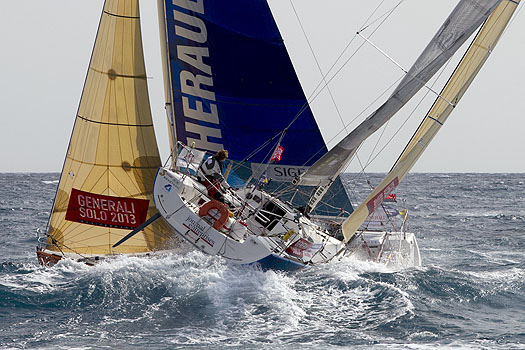
David Kenefick ducks a competitor in the Generali Solo. Photo: Alexis Courcoux
When I got to Dieppe I was destroyed. I had been warned about this period. I had become the fourth Irishman to complete the course over the race's 44-year history and was in a drunken haze and daze of extreme fatigue. I needed a break. I needed to reflect. I got the boat to Cowes, out of the water onto its cradle and went home to gather my thoughts. But this was the best time. Day by day I started to recover and realized I had achieved something. Worse was to come, as the days went by I realized this was the most amazing thing ever in the sailing world and the euphoria just wouldn't go away.
In the end we devised the second half of the season quickly. It was early July there were three big events left in the calendar, two of them two-handed (Fastnet and Tour of Brittany) and the last the Generali-Med which as the name suggests is in the Med.
When I was ready we started getting organized for the Fastnet Race which I sailed with Kinsale Dragon sailor Olaf Sorrensen. Then I did the Tour de Bretagne with Jeanne Gregoire, a very experienced Figaro racer, she had had more than her share of podium results over the previous few years. The goal was to really learn the Brittany coast and learn some tricks from an experienced sailor in a racing environment. Her part of the deal was to learn some English, but in reality it was another way for me to learn a bit more French.
In the background Marcus conjured up a deal for me to offset some of my costs for competing in the Med in September and as soon as I had completed the two handed race with Jeanne I was travelling South with my racing sails to prepare a borrowed boat for the Generali-Med.
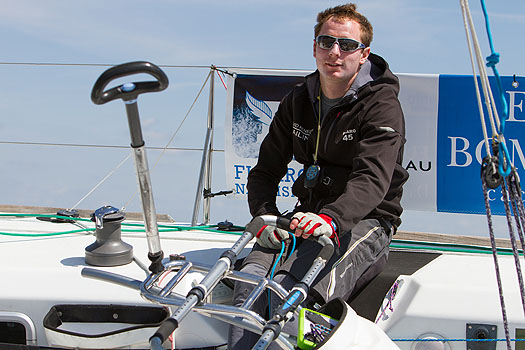
David Kenefick at the helm of Full Irish in his first successful year on the Pro Circuit. Photo: Brian Carlin
There were fewer boats in this event, for obvious cost and logistical reasons. It meant that the middle of the fleet from a standard point of view was removed. So at one end we had the top 12 boats competing for the season prizes and then the rookies and locals to the Med who hadn't raced anywhere else that year. The Med is different. No tide for sure but everything else about it is different. The wind doesn't behave as we Atlantic seaboard people understand, but it is still a boat race. This event was a mix of long offshore legs, not unlike the Solitaire, and two days of inshore racing at each of the stopovers. The balance of points meant that the combined value of all inshore races, amounting to 12 in the end, was worth the same as just one of the offshore legs.
I have just finished that event in 12th place from 17 starters. I was the best 2013 Rookie in this event and combined with my Solitaire du Figaro Rookie result I am the best newcomer in 2013. There is a reason the Rookie prize is there. No one comes into this scene and performs at the top in their first year. It can't be done and I now know why. If you had asked me about it 12 months ago I wouldn't have understood its value. Today I totally do and that is why I am more than excited about next year. I have five big priorities I want to work on for next year and I want to go out and do it all again and use the knowledge and experience from this year. It's a big challenge and the lessons I'm learning will be more than valuable for my whole life be it in sailing or any other activity.
Thanks for all your support, I'll keep you posted as we go forward.
Home next week for a long rest and to start preparing next years budget for sponsorship proposals.
DK
David Kenefick's Rookie Dream Dawns at Generali Solo
#fullirish – David Kenefick is in the running for the coveted 'Rookie of the Year Award' when the Generali Solo race concludes this weekend, here he talks (in the above eight minute podcast) about a successful debut in this month's Generali Solo race off the French coast. Chipping away at the fleet 'inch by inch' and 'mile by mile', the young Munster helmsman reflects on how hard it has been to crack the professional circuit, especially this series in a borrowed boat.
The offshore Generali fixture is a 1600–mile race broken into three stopovers, the equivalent of a 'Figaro' of the Mediterranean.
Despite many set backs (including lack of the local lingo) the 22-year-old Royal Cork sailor has literally put this latter part of the season together himself without any shore management and has been entirely responsible for rigging, derigging, logistics and safety compliance.
In what has been a baptism of fire, Kenefick was the youngest competitor in the Figaro, the Fastnet, the Solo Sab Delone, the Solo Concearneau, Solo Generali and Tour de Bretange. In 2013 he has sailed a total of 6000–7000 miles, inlcuding delivery trips, 90% of this has been single–handed.
After scoring 13, 10, 9 in 15 to 22 knots of wind in the Generali inshore races today, Kenefick has moved up the overall rankings by one place and now lies 12th, the next Rookie is 16th.
From this position the Cuskinny local has pulled himself into a situation where he stands a significant chance of winning tomorrow's 'Rookie of the Year' award, a major achievement.

Irish rookie David Kenefick (on port tack) is on target for an overall rookie award in the Generali Solo race this weekend. Photo: Alex Courcoux
#fullirish – After a full debut season on the French professional offshore solo sailing circuit, Cork's young David Kenefick has been punching above his weigh at the weekend in one of the last tests of the 2013 season. The 22–year–old Royal Cork sailor, who completed the arduous Figaro circuit in July and the Fastnet in August, was 12th in race 2 of the Generali Solo series. Kenefick took eighth in a fleet of 17 on Friday in the event's Grand Prix, prompting some to suggest Kenefick as a front runner for the solo circuit's coveted 'Rookie of the Year' award.
Kenefick Poised for Top Finish in Closing Stage of Generali Solo
#generalisolo – With just 52 miles to go in an offshore single-handed race from Barcelona to Bealieu sur Mer, Ireland's David Kenefick is ninth and in stronger breeze than closely packed rivals in the Generali Solo race this morning. Racing in a borrowed boat, the sole Irish competitor, a Figaro rookie in 2013, is currently well placed in leg two to finish out his debut season on a high if he can maintain his current speed of 4.2 knots. The Irish man has been racing for two days and has reported issues with jamming foils. More on the Generali Solo site. Click here.
Solo Kenefick Lying 15th in Generali Solo Light Wind Race to Barcelona
#fullirish – Royal Cork's David Kenefick is among 17 Figaro Benetau sailors in the Generali Solo 2013 left Cavalaire-sur-Mer on Sunday heading for Barcelona. A few miles after the start the race organisers announced a modification of the original route (435 miles) due to light winds over a large part of the stage. Currently the solo Irish sailor is placed 15th. Event website here.
The wind dropped in the middle of night. This morning Adrien Hardy (Recovery Act) is still ahead of Fabien Delahaye (Skipper Macif 2012) and Yoann Richomme (DLBC).
Since the passage of Cape Sicie at sunset, sailors nonetheless gained some miles, a little more than expected. The head of the fleet is now 140 miles distant from Barcelona. They crossed that night back and now continue on their way.. slowly pushed this morning at 5 o'clock by one knot of wind. The only good point is that with a wind shift they can now sail a direct course.
Top five at 5 AM local time:
1. Agir Recouvrement (Adrien Hardy)
2. Skipper Macif 2012 (Fabien Delahaye)
3. DLBC (Yoann Richomme)
4. Skipper Herault (Xavier Macaire)
5. Generali (Nicolas Lunven)
Generali Solo is a race in stages taking place in the Mediterranean Sea on Figaro Beneteau 2.
First stage: Cavalaire-Sur-Mer to Barcelona
Second: Barcelona to Beaulie Sur Mer (Departure September 25)
Third: Beaulieu-Sur-Mer to Sete, (Departure October 2)
Generali Solo is the final round of Solo Championship Elite de course au Large and has a coefficient of 4 in the overall standings. Provisional classification of the championship (top five)
1. DLBC, Yoann Richomme, 57 points
2. Cercle Verte, Gildas Morvan, 88
3. Skipper MACIF 2012. Fabien Delahaye, 89
4. Groupe Queguiner - Leucemie Espoir, Yann Elies, 95
5. Bretagne Credit Mutuel Performance, Anthony Marchand, 103
David Kenefick to Embark on 1,200 Mile Generali Solo race
#fullirish – Royal Cork's David Kenefick is competing in next week's Generali Solo race, a 1,200 mile single–handed race around the Med, consisting of three legs and starting on September 22nd.
The Generali solo is very much like La solitaire de Figaro, and is the final event of the Championship of France of Offshore racing for 2013.
Kenefick is currently ranked second rookie on the overall year standings and is hoping to go one better and make it to the top of the podium by the end of the Generali.
"It's great to be doing the Generali and to be in the hunt for the "Top Rookie Spot" for 2013 has been a long term goal for me for the season of 2013. Within 12 hours of finishing the Tour de Bretagne, he told Afloat.ie
'I was back in Port la Foret – (a 75 mile delivery) and had the boat out of the water and just over 24 hours. I was in the South of France stating to get Figaro 70 ready for the Generali, the boat that I will use for the event' he added.
According to local reports Kenefick's boat (The full Irish) is now in the water and ready to go while most of the fleet are still on their way here on the back of trucks.
I'm really looking forward to this event having learnt so much from sailing the Tour de Bretagne with one of the top Figaro sailors. It's going to be a very tough event yet again, and I'm expecting it to be even harder than the La Solitaire race itself as the seasons are changing in the Med and the weather is very hard to predict and anything can happen in a matter of minutes.
Generali Solo
Leg 1 : Cavalaire-sur-Mer – Barcelona •
Leg 2: Barcelona – Beaulieu-ser-Mer •
Leg 3 : Beaulieu-sur-Mer – Sète




























